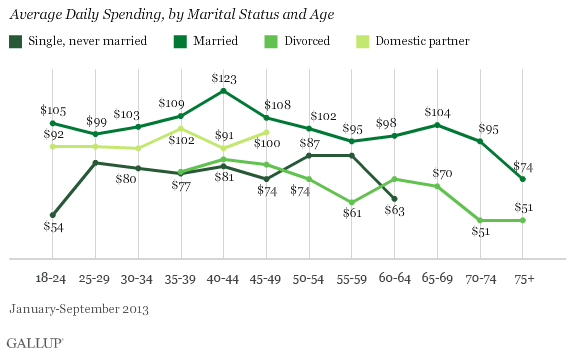PRINCETON, NJ -- Married Americans spend more than those in any other marital status category, across age groups. Americans who have never married spend significantly less, particularly for those younger than 50, suggesting that if the marriage rate increases, overall spending in the U.S. may increase and benefit the U.S. economy.

Married Americans report a daily spending average of $102, followed by $98 among those who are living in domestic partnerships, $74 by divorced Americans, $67 by those who are single and never married, and $62 by those who are widowed. As shown in the accompanying graph, across all age groups, those who are married spend more than those of other marital statuses.
Gallup asks Americans to report how much money they spent the prior day, excluding payments for normal household bills and major purchases such as homes or cars. The figure gives an estimate of discretionary spending. The current analysis is based on January through September 2013 Gallup Daily tracking interviews with more than 130,000 U.S. adults.
These results suggest that if more Americans are married, and fewer are single/never married, overall spending might increase. Similarly, if more Americans are in domestic partnerships and fewer are single, that too would appear to be related to higher spending.
The Relevance of Income
Married Americans spend more than the average American in part because they have higher-than-average incomes. Single Americans spend less, at least in part because they have lower-than-average incomes. Those in domestic partnerships spend almost as much as those who are married, but have lower average incomes, similar to single Americans' incomes, suggesting that domestic partners in some sense overspend what would be predicted from their incomes alone. This hypothesis is supported by additional research showing that those in domestic partnerships have a relatively high rate of spending when income and other demographic factors are controlled for.
Conclusions
The U.S. marriage rate has declined in recent years, but recent Gallup analysis shows that it is possible that the marriage rate in the United States will go up in the future, based on a pent-up demand for marriage. Based on the spending habits of married Americans compared with their single counterparts who have never married, such a change could be expected to give a boost to the economy, if those marriages come from the ranks of those who are single/never married. Similarly, an increase in the percentage of Americans living in domestic partnerships as opposed to being single would have an apparently positive impact on the economy. If, however, Americans in the future become less likely to jump from single status to marriage and more likely to move into domestic partnerships, the impact on the economy would be less significant.
Survey Methods
These results are based on telephone interviews conducted Jan. 1-Sept. 30, 2013, on the Gallup Daily tracking survey, with a random sample of 135,537 adults, aged 18 and older, living in all 50 U.S. states and the District of Columbia.
For results based on the total sample of national adults, one can say with 95% confidence that the margin of sampling error is ±1 percentage point.
For results based on the total sample of 72,106 married Americans, one can say with 95% confidence that the margin of sampling error is ±1 percentage point.
For results based on the total sample of 26,514 single/never married Americans, one can say with 95% confidence that the margin of sampling error is ±1 percentage point.
For results based on the total sample of 4,686 Americans in a domestic partnership, one can say with 95% confidence that the margin of sampling error is ±2 percentage points.
Interviews are conducted with respondents on landline telephones and cellular phones, with interviews conducted in Spanish for respondents who are primarily Spanish-speaking. Each sample of national adults includes a minimum quota of 50% cellphone respondents and 50% landline respondents, with additional minimum quotas by region. Landline and cell telephone numbers are selected using random-digit-dial methods. Landline respondents are chosen at random within each household on the basis of which member had the most recent birthday.
Samples are weighted to correct for unequal selection probability, nonresponse, and double coverage of landline and cell users in the two sampling frames. They are also weighted to match the national demographics of gender, age, race, Hispanic ethnicity, education, region, population density, and phone status (cellphone only/landline only/both, and cellphone mostly). Demographic weighting targets are based on the March 2012 Current Population Survey figures for the aged 18 and older U.S. population. Phone status targets are based on the July-December 2011 National Health Interview Survey. Population density targets are based on the 2010 census. All reported margins of sampling error include the computed design effects for weighting.
In addition to sampling error, question wording and practical difficulties in conducting surveys can introduce error or bias into the findings of public opinion polls.
For more details on Gallup's polling methodology, visit www.gallup.com.
